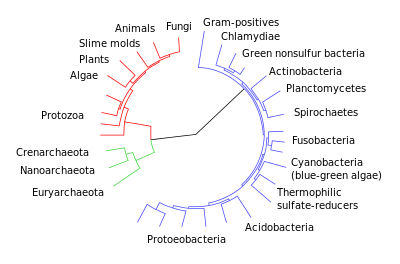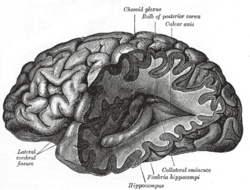Evolutionary neuroscience
| Part of a series on |
| Evolutionary biology |
|---|
 |
|
History of evolutionary theory |
|
Fields and applications
|
|
Evolutionary neuroscience is an interdisciplinary scientific research field that studies the evolution of nervous systems. Evolutionary neuroscientists attempt to understand the evolution and natural history of nervous system structure and function. The field draws on concepts and findings from both neuroscience and evolutionary biology. Historically, most empirical work has been in the area of comparative neuroanatomy, and modern studies often make use of phylogenetic comparative methods. Selective breeding and experimental evolution approaches are also being used more frequently.[1]
Conceptually and theoretically, the field is related to fields as diverse as comparative psychology, neuroethology, developmental neurobiology, evo-devo, behavioral ecology, biological anthropology, sociobiology, cognitive neuroscience, sociocultural evolution and evolutionary psychology.
History
The field began after the publication of Darwin's On the Origin of Species, but brain evolution was largely viewed at the time in relation to the incorrect scala naturae. The 1936 book The Comparative Anatomy of the Nervous System of Vertebrates Including Man by the Dutch neurologist C.U. Ariëns Kappers (first published in German in 1921) was a landmark publication in the field. Following the Evolutionary Synthesis, the study of comparative neuroanatomy was conducted with an evolutionary view, and modern studies incorporate developmental genetics.[2][3]
Researchers
- John Allman
- William H. Calvin
- Terrence Deacon
- Merlin Donald
- Jon Kaas
- Glenn Northcutt
- Georg F. Striedter
See also
- Evolution of the brain
- Evolution of nervous systems
- Evolutionary physiology
- Evolutionary psychology
- FOXP2 and human evolution
- Neuroethology
References
- ↑ Rhodes, J. S., and T. J. Kawecki. 2009. Behavior and neurobiology. Pp. 263–300 in Theodore Garland, Jr. and Michael R. Rose, eds. Experimental Evolution: Concepts, Methods, and Applications of Selection Experiments. University of California Press, Berkeley.
- ↑ Northcutt, R. Glenn (August 2001). "Changing views of brain evolution". Brain Research Bulletin. 55 (6): 663–674. doi:10.1016/S0361-9230(01)00560-3.
- ↑ Striedter, G. F. (2009). "History of ideas on brain evolution". In Jon H Kaas. Evolutionary Neuroscience. Academic Press. ISBN 0-12-375080-6.
- ^ Boer, Sietse F. De, Doretta Caramaschi, Deepa Natarajan, and Jaap M. Koolhaas. (2009) "The Vicious Cycle Towards Violence: Focus on the Negative Feedback Mechanisms of Brain Serotonin Neurotransmission." Frontiers in Behavioral Neuroscience
- ^ Natarajan, Deepa, and Doretta Caramaschi. (2010). "Animal violence demystified". National Center for Biotechnology Information. U.S. National Library of Medicine
External links
- Brain Behavior and Evolution - (Journal)
- "Comparative Vertebrate Neuroanatomy: Evolution and Adaptation" - Ann B. Butler, William Hodos
- Sinauer.com - Principles of Brain Evolution Georg F. Striedter, University of California, Irvine' (book review, 2004)
